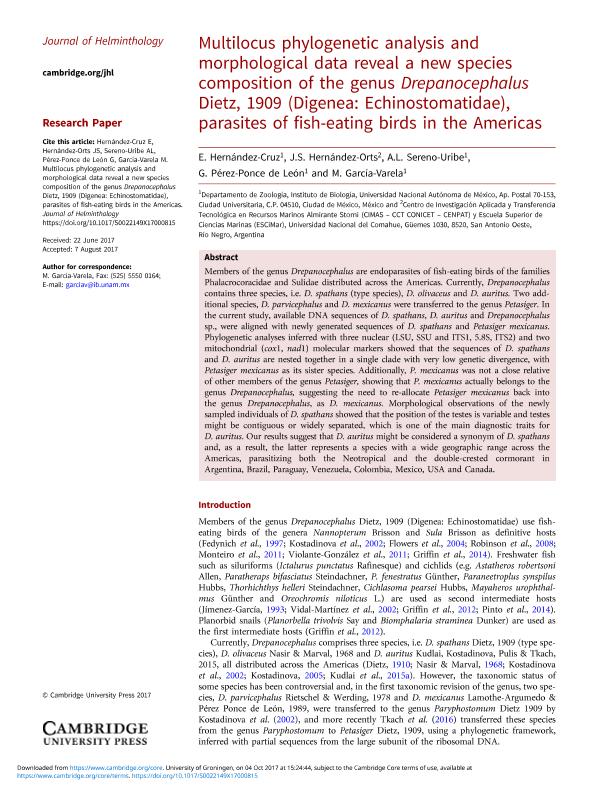Artículo
Multilocus phylogenetic analysis and morphological data reveal a new species composition of the genus Drepanocephalus Dietz, 1909 (Digenea: Echinostomatidae), parasites of fish-eating birds in the Americas
Hernández Cruz, E.; Hernández Orts, Jesús Servando ; Sereno Uribe, A. L.; Pérez Ponce De León, G.; García Varela, M.
; Sereno Uribe, A. L.; Pérez Ponce De León, G.; García Varela, M.
 ; Sereno Uribe, A. L.; Pérez Ponce De León, G.; García Varela, M.
; Sereno Uribe, A. L.; Pérez Ponce De León, G.; García Varela, M.
Fecha de publicación:
09/2018
Editorial:
Cambridge University Press
Revista:
Journal Of Helminthology
ISSN:
0022-149X
Idioma:
Inglés
Tipo de recurso:
Artículo publicado
Clasificación temática:
Resumen
Members of the genus Drepanocephalus are endoparasites of fish-eating birds of the families Phalacrocoracidae and Sulidae distributed across the Americas. Currently, Drepanocephalus contains three species, i.e. D. spathans (type species), D. olivaceus and D. auritus. Two additional species, D. parvicephalus and D. mexicanus were transferred to the genus Petasiger. In the current study, available DNA sequences of D. spathans, D. auritus and Drepanocephalus sp., were aligned with newly generated sequences of D. spathans and Petasiger mexicanus. Phylogenetic analyses inferred with three nuclear (LSU, SSU and ITS1, 5.8S, ITS2) and two mitochondrial (cox1, nad1) molecular markers showed that the sequences of D. spathans and D. auritus are nested together in a single clade with very low genetic divergence, with Petasiger mexicanus as its sister species. Additionally, P. mexicanus was not a close relative of other members of the genus Petasiger, showing that P. mexicanus actually belongs to the genus Drepanocephalus, suggesting the need to re-allocate Petasiger mexicanus back into the genus Drepanocephalus, as D. mexicanus. Morphological observations of the newly sampled individuals of D. spathans showed that the position of the testes is variable and testes might be contiguous or widely separated, which is one of the main diagnostic traits for D. auritus. Our results suggest that D. auritus might be considered a synonym of D. spathans and, as a result, the latter represents a species with a wide geographic range across the Americas, parasitizing both the Neotropical and the double-crested cormorant in Argentina, Brazil, Paraguay, Venezuela, Colombia, Mexico, USA and Canada.
Palabras clave:
Digena
,
Drepanocephalus
,
Phalacrocoracidae
,
Mexico
Archivos asociados
Licencia
Identificadores
Colecciones
Articulos(CIMAS)
Articulos de CENTRO DE INVESTIGACION APLICADA Y TRANSFERENCIA TECNOLOGICA EN RECURSOS MARINOS "ALMIRANTE STORNI"
Articulos de CENTRO DE INVESTIGACION APLICADA Y TRANSFERENCIA TECNOLOGICA EN RECURSOS MARINOS "ALMIRANTE STORNI"
Articulos(SEDE CENTRAL)
Articulos de SEDE CENTRAL
Articulos de SEDE CENTRAL
Citación
Hernández Cruz, E.; Hernández Orts, Jesús Servando; Sereno Uribe, A. L.; Pérez Ponce De León, G.; García Varela, M.; Multilocus phylogenetic analysis and morphological data reveal a new species composition of the genus Drepanocephalus Dietz, 1909 (Digenea: Echinostomatidae), parasites of fish-eating birds in the Americas; Cambridge University Press; Journal Of Helminthology; 92; 5; 9-2018; 572-595
Compartir
Altmétricas



